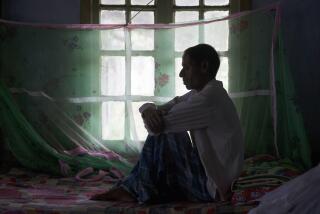AIDS Cases Hit a 15-Year Low
- Share via
The number of AIDS cases reported in California dropped to a 15-year low in 2001, officials said, largely because of prescription drugs that can keep the full-blown disease at bay for years.
In 2001, the state Department of Health Services received 4,227 reports of new AIDS cases, down 11.2% from 2000. In 1993, the state reported a record 18,964 cases.
But officials caution that the figures can be misleading because they represent the number of AIDS cases, not new infections of the human immunodeficiency virus that causes AIDS. Experts say the same prescription drugs that can prolong the lives of HIV and AIDS patients have been interpreted by some as an excuse not to practice safe sex.
Several studies have found a resurgence in risky sexual behavior, particularly among young gay and bisexual men, and suggest that HIV infections are increasing in major urban centers, including Los Angeles and San Francisco.
The statistics are useful, though, because they allow officials to determine whether medications and support services are reaching all segments of the population, or if disparities exist among different minority groups.
California’s decline differs from the national experience. Federal health officials say the number of new AIDS cases stopped dropping in 1998 after years of dramatic declines. For the next two years, about 10,000 people became infected with AIDS each quarter.
Experts attribute California’s distinctive pattern to demographics. In California, HIV and AIDS are more prevalent among gay and bisexual men, who seek testing earlier and have better access to health care. As a result, prescription drugs have been able to delay the onset of AIDS for a longer period of time, public health officials say.
In many other places in the nation, the disease affects a higher percentage of minorities, women and injection drug users, who may not seek treatment or may not have the same access to medications. Because of these gaps, they may develop AIDS more quickly.
Because it can take 10 or more years for an HIV-positive person to develop AIDS, the 2001 reports represent mostly those who were infected in the late 1980s or early 1990s. As a result interpreting the numbers is difficult.
Public health officials don’t want to send the wrong message. “It’s a very tricky balance to maintain,” said Gunther Freehill of the Los Angeles County Office of AIDS Programs and Policy. “You want people to know that there’s hope, yet you don’t want them to take risk. It’s really much better not to get HIV in the first place.”
Dana Van Gorder, director of state and local affairs for the San Francisco AIDS Foundation, agrees. “Everybody hates to say that this trend isn’t a good one ... [but] there is concern that, at some point, the trend may begin to reverse itself.”
In San Francisco, for instance, experts estimated that new cases of HIV infection increased to 1,122 last year from 499 in 1997. More than 800 of the new cases were among men who have sex with men, the experts speculated.
Most states collect data on new HIV cases, allowing officials to gauge how many people are infected in any given year. Beginning later this year, the California office of AIDS will assign HIV patients a unique code that will help track the spread of the epidemic.
More to Read
Sign up for Essential California
The most important California stories and recommendations in your inbox every morning.
You may occasionally receive promotional content from the Los Angeles Times.












